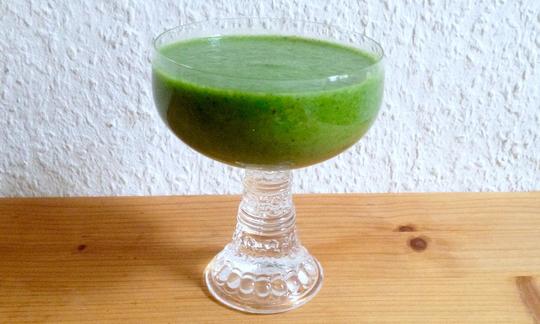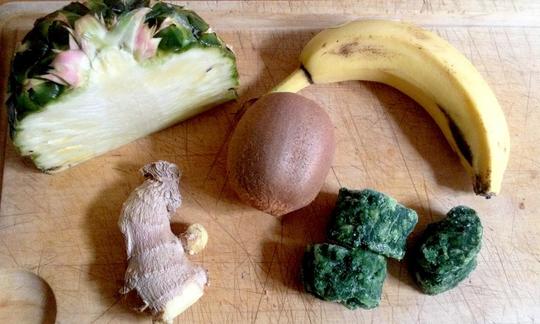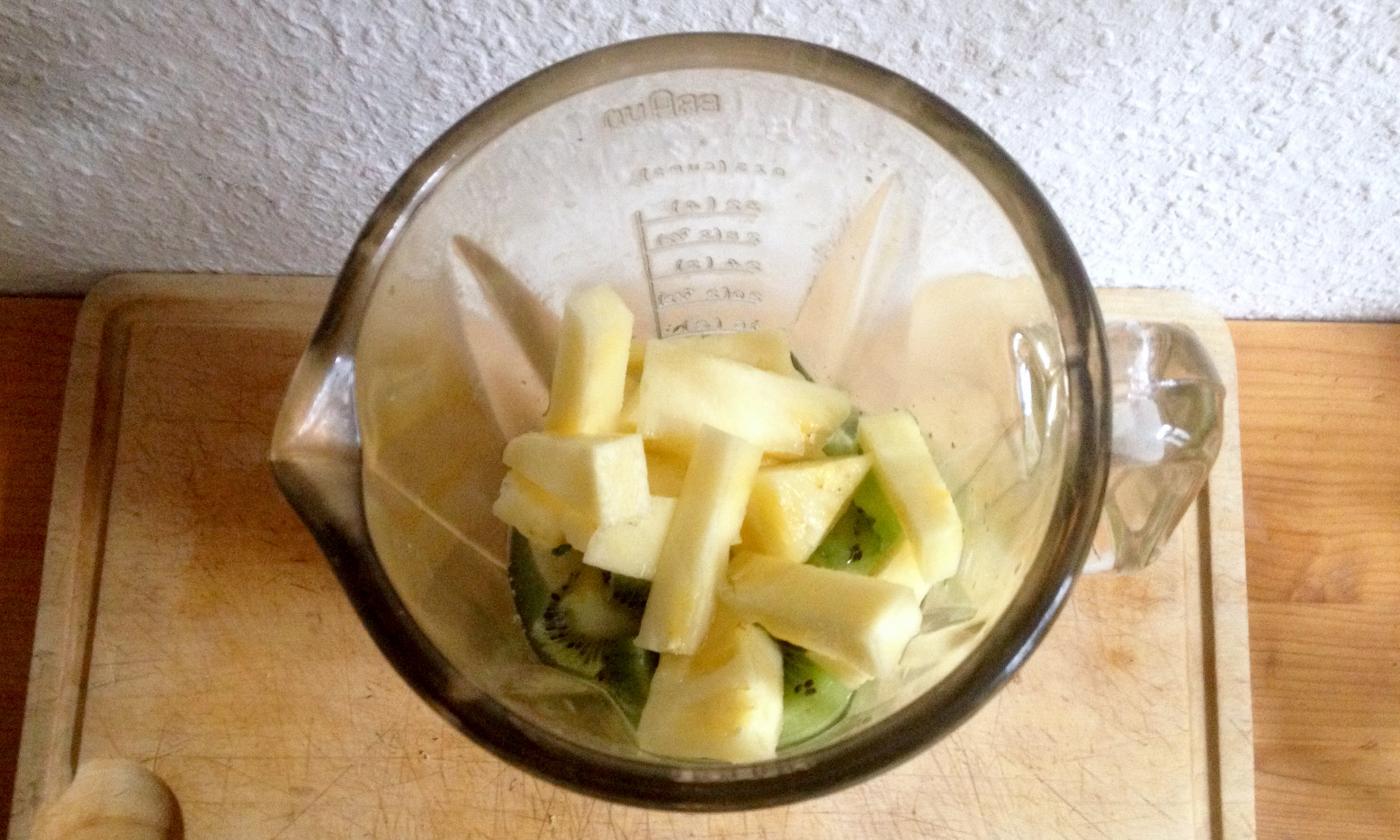Tropical Green Smoothie with Spinach
raw-vegan
Ingredients (for servings, )
| 2 ½ oz | Spinach, frozen, chopped (organic?) |
| 250 ml | Drinking water, raw (organic?) (8.8 oz) |
| 1 | Bananas, raw (organic?) (4.1 oz) |
| 1 | Kiwi, green (raw, organic?) (3.9 oz) |
| 5 ½ oz | Pineapple, raw (organic?) |
| ⅛ oz | Ginger, raw (organic?) |
Equipment
- hand-held blender / immersion blender or blender
Type of preparation
- food preparation without heating
- blend
Preparation
Place the spinach in the blender and add 250 ml of lukewarm water.
The warmer water helps the spinach to thaw out a bit, which makes it easier for the blender to process it.
Peel the fruit, cut into small pieces, and add to the blender.
If you don’t have a high-speed blender, you can blend after each step in order to make it easier for your blender.
Peel the ginger, cut into small pieces, and add to the rest of the ingredients to the blender.
It works best to peel ginger using the sharp outer edge of a spoon. With the outer edge of the spoon, you can scrape off only the brown skin and none of the inner yellow part is wasted.
Blend all of the ingredients on the highest speed until a smooth consistency is achieved. Then either serve the green smoothie immediately or refrigerate briefly before serving.
|
Nutritional Information per person
Convert per 100g
|
2000 kcal | |
|---|---|---|
| Energy | 135 kcal | 6.7% |
| Fat/Lipids | 0.78 g | 1.1% |
| Saturated Fats | 0.10 g | 0.5% |
| Carbohydrates (inc.dietary fiber) | 33 g | 12.2% |
| Sugars | 20 g | 22.0% |
| Fiber | 5.3 g | 21.1% |
| Protein/Albumin | 3.0 g | 5.9% |
| Cooking Salt (Na:34.0 mg) | 86 mg | 3.6% |
| Essential micronutrients with the highest proportions | per person | 2000 kcal | |
|---|---|---|---|
| Vit | Vitamin K | 153 µg | 204.0% |
| Vit | Vitamin C (ascorbic acid) | 94 mg | 117.0% |
| Min | Manganese, Mn | 1.2 mg | 58.0% |
| Vit | Folate, as the active form of folic acid (née vitamin B9 and | 90 µg | 45.0% |
| Elem | Potassium, K | 590 mg | 29.0% |
| Vit | Vitamin B6 (pyridoxine) | 0.40 mg | 28.0% |
| Min | Copper, Cu | 0.26 mg | 27.0% |
| Vit | Vitamin A, as RAE | 211 µg | 26.0% |
| Prot | Tryptophan (Trp, W) | 0.05 g | 21.0% |
| Elem | Magnesium, Mg | 62 mg | 17.0% |
Detailed Nutritional Information per Person for this Recipe
The majority of the nutritional information comes from the USDA (US Department of Agriculture). This means that the information for natural products is often incomplete or only given within broader categories, whereas in most cases products made from these have more complete information displayed.
If we take flaxseed, for example, the important essential amino acid ALA (omega-3) is only included in an overarching category whereas for flaxseed oil ALA is listed specifically. In time, we will be able to change this, but it will require a lot of work. An “i” appears behind ingredients that have been adjusted and an explanation appears when you hover over this symbol.
For Erb Muesli, the original calculations resulted in 48 % of the daily requirement of ALA — but with the correction, we see that the muesli actually covers >100 % of the necessary recommendation for the omega-3 fatty acid ALA. Our goal is to eventually be able to compare the nutritional value of our recipes with those that are used in conventional western lifestyles.
| Essential fatty acids | per person | 2000 kcal |
|---|---|---|
| Alpha-Linolenic acid; ALA; 18:3 omega-3 | 0.08 g | 4.0% |
| Linoleic acid; LA; 18:2 omega-6 | 0.18 g | 2.0% |
| Essential amino acids | per person | 2000 kcal |
|---|---|---|
| Tryptophan (Trp, W) | 0.05 g | 21.0% |
| Threonine (Thr, T) | 0.13 g | 14.0% |
| Lysine (Lys, K) | 0.17 g | 9.0% |
| Phenylalanine (Phe, F) | 0.14 g | 9.0% |
| Valine (Val, V) | 0.14 g | 9.0% |
| Isoleucine (Ile, I) | 0.10 g | 8.0% |
| Leucine (Leu, L) | 0.17 g | 7.0% |
| Methionine (Met, M) | 0.04 g | 5.0% |
| Vitamins | per person | 2000 kcal |
|---|---|---|
| Vitamin K | 153 µg | 204.0% |
| Vitamin C (ascorbic acid) | 94 mg | 117.0% |
| Folate, as the active form of folic acid (née vitamin B9 and | 90 µg | 45.0% |
| Vitamin B6 (pyridoxine) | 0.40 mg | 28.0% |
| Vitamin A, as RAE | 211 µg | 26.0% |
| Vitamin E, as a-TEs | 1.9 mg | 16.0% |
| Thiamine (vitamin B1) | 0.13 mg | 11.0% |
| Riboflavin (vitamin B2) | 0.16 mg | 11.0% |
| Biotin (ex vitamin B7, H) | 5.5 µg | 11.0% |
| Pantothenic acid (vitamin B5) | 0.49 mg | 8.0% |
| Niacin (née vitamin B3) | 1.1 mg | 7.0% |
| Essential macroelements (macronutrients) | per person | 2000 kcal |
|---|---|---|
| Potassium, K | 590 mg | 29.0% |
| Magnesium, Mg | 62 mg | 17.0% |
| Calcium, Ca | 80 mg | 10.0% |
| Phosphorus, P | 55 mg | 8.0% |
| Sodium, Na | 34 mg | 4.0% |
| Essential trace elements (micronutrients) | per person | 2000 kcal |
|---|---|---|
| Manganese, Mn | 1.2 mg | 58.0% |
| Copper, Cu | 0.26 mg | 27.0% |
| Iron, Fe | 1.2 mg | 9.0% |
| Zinc, Zn | 0.47 mg | 5.0% |
| Selenium, Se | 2.9 µg | 5.0% |
| Fluorine, F | 90 µg | 3.0% |
| Iod, I (Jod, J) | 5.0 µg | 3.0% |
Perfect for those who like to drink their serving of spinach. This delicious green smoothie packed with healthy nutrients can be prepared in just five minutes.
Smoothies are more than just a drink: We sometimes forget that smoothies are more like a meal or a snack than a drink and that we usually have to chew the ingredients longer — unless the smoothie has achieved a very fine consistency in the blender. It is only when we chew our food longer and it stays in our mouth longer that our glands can produce and supply the necessary digestive juice. Smoothies are only really healthy if you sip them slowly and don't just gulp them down.
Using fresh spinach: For many people, the choice is based on cost. Since the leaves are delicate, transport is quite expensive, which makes fresh spinach sold at the grocery store much more expensive than processed (frozen) spinach. “Fresh” spinach is also sold packaged in plastic bags and tubs. However, this type of spinach is often treated with nitrogen gas or exposed to radiation as bacteria grow more quickly under the plastic. Packaged spinach also contains fewer vitamins than truly fresh spinach. But people who regularly cook using fresh ingredients of high quality definitely appreciate the taste of fresh spinach over processed spinach.
Drinking smoothies correctly: It is best to drink smoothies with a wide straw. These are also available in glass or stainless steel. It is recommended that you drink your smoothie slowly so that the nutrients it contains can be better absorbed. And you shouldn’t forget that smoothies are more like a meal or a snack than a drink.
Fresh spinach: Instead of the frozen spinach, you can also use fresh spinach. In general, you should choose fresh products whenever possible. For this recipe (2 servings), replace the 70 g of frozen spinach with a medium-size handful of fresh spinach leaves.
Adding more ginger: If you like ginger and aren‘t afraid of its characteristic pungent taste, you can double the amount of ginger that this recipe calls for.








